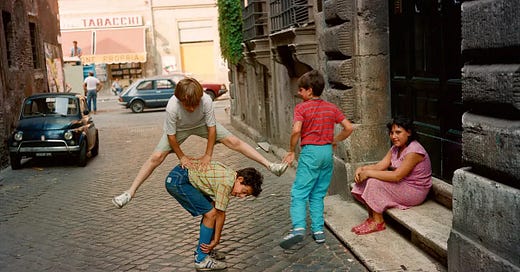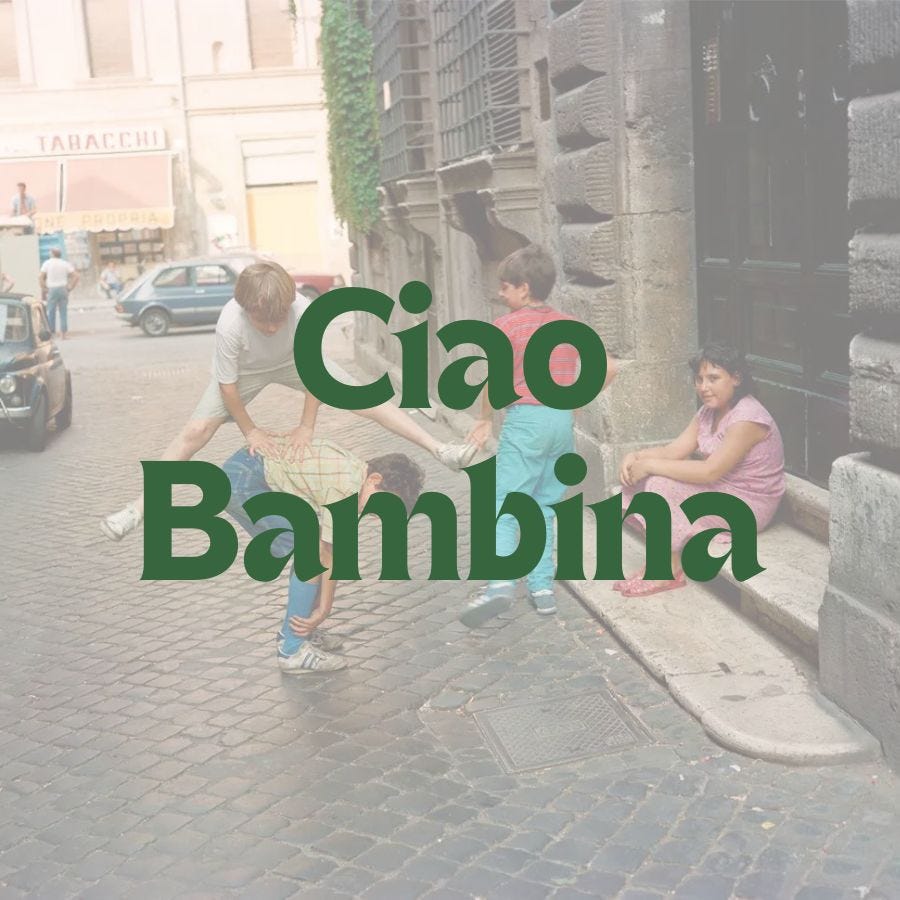A few weeks into my time in Rome, I remarked to a friend that it was all just so chaotic. Quickly realizing that of course Rome’s chaotic: it’s been continually inhabited by huge swaths of people for thousands of years. It’s something I will never quite grasp. How casually that history is enfolded within Rome’s modernity, how easy it is to happen upon ancient ruins and evidence of tragedy and triumph. Each time I come across SPQR, I’m stunned. I really shouldn’t be: while it was first used in 753 BC to refer to the governing bodies of the Roman Republic, it is still used today in Rome’s coat of arms. Maybe it’s because I’m American and what we consider old in our country the Romans would spit on for how infantile it all is.
My apartment in Monteverde sat upon a hill atop Trastevere, so I walked through the neighborhood almost every day to and from exploring the rest of Rome. There were a few different routes to get from Monteverde down to one of the oldest enclaves in the city, but whatever route I took, it always involved hundreds of stairs or slightly fewer stairs paired with long sloping streets. There was no other way around it. But the stairs were made of stone that had character, greenery erupted from either side, and colorful apartment buildings peaked through the foliage. The process was charming going down, less so coming back up. Though I found my panting had dissipated towards the end of my trip, which felt like a major accomplishment as a not particularly athletic individual. Every now and then I’d come across a teenager or two, perched on the wall beside a set of stairs reading a book, and immediately was endeared towards the youth of Italy. Halfway down, I was once approached by lost British tourists who tried to speak to me in broken Italian and was flattered beyond reason that I somehow appeared to be a local.
Trastevere is a neighborhood that both excites and annoys me. There is the allure of weathered winding streets filled with coffee shops that turn into bars, a biscotti bakery whose aroma wafts through the air, heaps of vines spilling down half the buildings, endless offerings for pizza and pasta and prosciutto, snug enoteche around every corner, snug little bookstores, and gelatarias that use rose water and figs in their recipes. Yes, much of this is found throughout the rest of Rome, but Trastevere has a certain cozy charm to it that makes it feel particularly special. But with these things come the inevitable: hordes of tourists. I adore Trastevere in the morning when it’s mostly quiet as a handful of people sip espresso and the restaurants are just getting set up for the day. I tolerate the neighborhood in the busy afternoon, but enjoy it again in aperitivo when the crowds thin out and those who linger idly sip their Aperol Spritz. And then I do my best to just breeze right on through in the evening as the tourists get deeper into their cups and the streets are just overrun with the overly sauced.
I’m not mistaken in thinking I was local just because I stayed in this city longer than most people do on a trip to Rome. Rather, throughout this trip I was bewildered by how often I was confronted with more crowds than I ever recalled seeing in this country. I can’t imagine what it’s like to actually be Italian and experience this. Yes, the joke of this past summer was that everyone was in Europe, but that still felt very true in the fall. How were this many people on vacation on a Wednesday in October?! How did this many trattorias become Internet famous and now have lines of a hundred people waiting to get a table?! The anxiety these crowds gave me made me decide not to revisit the heavy hitters that are always swarming with tourists: the Colosseum, the Vatican, the Trevi Fountain. Ok, in actuality my curiosity got the better of me and on one of my last days I did visit the Trevi Fountain for “anthropological” reasons and was astounded, just as I expected to be. I lasted about two minutes before quickly walking away, desperately buying a chocolate hazelnut and pistachio gelato to recover.
I observed the Colosseum and the Vatican from afar on several occasions and was still overcome with emotion each time I spotted them, whispering to myself “that’s the fucking Colosseum!” and “I wonder what the pope’s doing right now?” These icons of history and tradition and Italian identity were still so powerful, even without stepping foot in them. Would I have liked to have stood in the Sistine Chapel again? Of course. But my one experience in it years ago was a fabulously lucky exception to the norm wherein I managed to spend an entire minute amongst Michelangelo’s work with barely anyone else there, jaw agape in wonder. I vote for keeping the memory of that transcendent space as it is. The legend of how it came to exist in the first place is one of my favorite tidbits of Roman history…
The story goes that prior to painting the Sistine Chapel, Michelangelo had been working on sculpting Pope Julius’s tomb. He was adored by the Pope and the other artists working within the Vatican were rather irritated by it, most notably Raphael. And so, Raphael tried his best to undermine Michelangelo’s reputation, telling the Pope that it was inviting death to build your own tomb. The Pope changed course and reassigned Michelangelo to paint the ceiling of the Sistine Chapel. Raphael and Bramante were delighted: Michelangelo was a sculptor, not a painter. They would finally see him fail and find themselves elevated to a higher status. What resulted is the stuff of Rome legend: “Michelangelo locked himself into the Sistine Chapel: no one was allowed in, not even [Pope] Julius. It seemed that to fetter Michelangelo was simply to make his myth the more powerful. Soon, all of Rome was fixated by the mystery of what lay behind that locked door. Then, according to Vasari, Michelangelo had to leave Rome for a few days, and while he was away Bramante got hold of the keys. He and Raphael went in to look. And what they saw, of course, was the preeminent artistic achievement of the Renaissance and perhaps of the whole history of art, past, present, and future.” (Rachel Cusk, The Last Supper) Why this spat of artistic rivalry at the Vatican has not been turned into a bingeable drama on Netflix or HBO is truly a mystery. The sets would be expensive, but the petty feuds and backstabbing via high achievements in paint and plaster would be worth it.
Despite Rome overflowing with compelling sites to visit, I can skip the obvious go-tos and still be gobsmackingly delighted by what I discover. This is the joy in revisiting a place you’ve already been to, you can dive in deeper and actually get to know the city. I have a strong sense of direction and seem to remember where things are in relation to one another to an alarming degree (when I was fifteen I gave a cab driver directions after only having been in Bangkok for a matter of hours), so it doesn’t take long for the city to feel familiar. It allows me to wander often without referring to a map, with the lovely whim of discovery while never feeling panicked that I’m lost.
I find favorite coffee shops and little streets I like to walk down, I return to the same forno each week for pizza, and I do my best to try each gelataria that I’ve heard is “the best.” I visit museums that used to be private homes, overflowing with frescos and an odd assortment of artifacts. I step into basilicas on a whim and am entranced by the exorbitant amount of gold leaf applied throughout the space, and how it glistens in the sunlight coming through the windows. Still, what excites me the most while walking through Rome are the relics from centuries ago that are just out in the open, exposed to the elements, integrated into the landscape of the city.
I think it’s that all of these things have survived for so long that I become swept up in the history of Rome. There are countless physical reminders of events and ways of life that happened hundreds or thousands of years ago. And it’s unclear just how old any of these objects are because rarely is there ever some kind of plaque or marking, and if there is, it’s usually so worn down you can’t read it. So you’re left to guess: is it two hundred years old? Or two thousand? Surely if it were that old it wouldn’t be out on the street, or would it? The Colosseum, Forum, Baths of Caracalla, and countless other remnants from the Roman Empire rest in their place, slowly weathering with each passing century. Sometimes it’s a stone foot atop a plinthe that I stumble upon, others it’s several columns that were part of the structure of… what exactly? How are these relics important enough to still be here, albeit tucked behind lackluster fencing, and others are protected by a foundation or museum, requiring a ticket to see? I also come across fragments of sculptures in various parks around the city and drinking fountains that have water pouring out of stone wine barrels. Can they actually be seen as relics? Or is this the work of nostalgia in the 19th century, building new things to appear as if they are quite old?
Ruins are so ubiquitous in Rome, there is the possibility of growing used to them. But it never happens for me. I’m dumbfounded upon each encounter, even when I’ve seen a particular crumbled temple or stone foot a dozen times. Perhaps it’s because they offer a window into another era: aesthetics and hierarchies, everyday functionality and belief systems. As with all art and architecture, they serve as records of what was important at that particular moment in time. Or maybe it’s because they make me reflect on the fact that despite the years between when these objects were put in place and me gazing upon them now, not a whole lot actually has changed in how society functions and what drives people. We strive for beauty, permanence, and a sense of purpose just as much today as they did then. And I love that stumbling upon a ruin from the Roman Empire, or maybe just the 19th century, stirs all this up for me. Amusingly, the meme of “how many times a day do you think about the Roman Empire?” was circulating during this trip. I couldn’t help but laugh because for that particular moment in my life, my answer was “at least twenty times a day.”
In my last week in Italy, I still wished to wander the streets of Rome, but my energy for it was fading. My solution: put my headphones in and listen to a playlist of spunky Italian tunes while I walk. And let me tell you, it made every last detail of Rome as enchanting, amusing, and romantic as ever, like I was in the fun sightseeing montage of a movie. I loved it and wished I had done it sooner. I’m sharing that collection of songs with you this week, to enjoy on your own promenade through Rome, or just as a fun soundtrack while you cook some spaghetti.
Next week: I’m diving into the idea of Italy as a cure for everything. A presto!
— Katie











